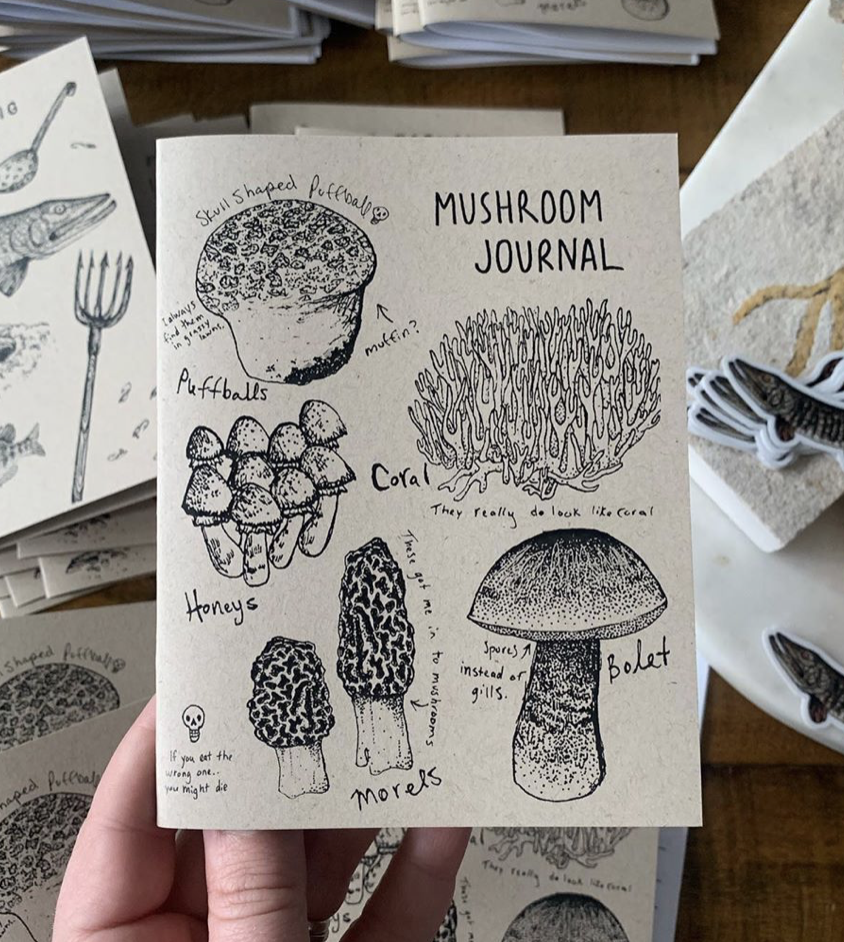Imagine a world teeming with vibrant colors, strange shapes, and hidden secrets. This world exists just beneath our feet, in the shadowy embrace of the forest floor, and it’s filled with an incredible array of fungi—the often overlooked but fascinating kingdom of mushrooms. A mushroom journal is more than just a record of your forays into the fungal realm; it’s a passport to a world of intrigue and discovery.

Image: naturewalkstudio.com
For the budding mycologist, the seasoned naturalist, or simply the curious observer, a mushroom journal serves as a personal chronicle of your fungal encounters. It’s a place to document your findings, share your experiences, and unravel the fascinating secrets of the fungal kingdom. This article delves into the world of mushroom journaling, exploring its benefits, practical applications, and most importantly, the joy of connecting with the diverse and enchanting world of mushrooms.
Why Keep a Mushroom Journal?
Beyond its aesthetic appeal, a mushroom journal offers a multitude of benefits for both novice and experienced mushroom enthusiasts. Here are just a few reasons why keeping a mushroom journal is a rewarding endeavor:
- Learning and Observation: By meticulously recording your observations, you’ll foster a deeper understanding of mushroom identification, growth patterns, and ecological roles. You’ll notice subtle variations in color, shape, and texture, helping you distinguish between different species.
- Documentation and Memory: The act of journaling helps you retain knowledge and appreciate the fleeting beauty of nature. Over time, your journal will become a treasure trove of memories, revealing the evolution of your mycological knowledge and the changing seasons.
- Scientific Value: Detailed observations contribute to our understanding of fungal biodiversity and distribution. Scientific data gathered through citizen science initiatives relies heavily on the meticulous records kept by passionate individuals like yourself.
- Fungal Connections: A mushroom journal can become a personal connection to a vast network of unseen organisms beneath your feet. You’ll develop a deeper appreciation for the interconnectedness of life within a forest ecosystem.
Essential Elements of a Mushroom Journal
A successful mushroom journal blends scientific observation with artistic expression — a captivating blend of data and personal reflections. Here are some key elements to incorporate into your journal:
1. Detailed Descriptions
The core of a mushroom journal lies in meticulous descriptions. Capture the following details:
- Date and Location: Note the date, time, and precise location (including GPS coordinates if possible) where you found the mushroom. This helps track the fungus’s habitat and potential seasonal variations.
- Habitat Details: Record the surrounding environment—type of forest, soil conditions, nearby trees, and any other prominent features. This information connects the mushroom to its specific ecosystem.
- Macroscopic Features: Describe the mushroom’s cap, gills, stem, and overall appearance using clear language. Include details like color, size, shape, texture, and any unique markings.
- Microscopic Observations: If you have access to a microscope, documenting microscopic features like spore prints and gill structure adds a scientific dimension to your journal.
- Smell and Taste (with caution): Some mushrooms have distinct smells and tastes. Note these carefully, but only with non-poisonous fungi and always in minimal amounts.

Image: www.etsy.com
2. Illustrations and Photographs
Visuals are invaluable in mushroom identification and journaling. Here’s how to utilize them effectively:
- Sketches: Drawing mushrooms helps you pay close attention to their shapes and forms. Artistic talent is not required; even simple line drawings can be informative.
- Photographs: Capture high-quality images of the mushroom from various angles, making sure to include context like the surrounding environment. High-resolution images allow for detailed analysis later.
- Labeling: Annotate your drawings and photos with essential details like the mushroom’s name (if identified), date, and location. This helps you organize your observations and make them easily accessible.
3. Personal Reflections and Observations
Beyond scientific data, your observations and insights are equally important. Write down:
- Your Thoughts and Feelings: Describe your initial reaction to discovering the mushroom. Was it intriguing, beautiful, or even a bit eerie? Your personal impressions add depth and intrigue to your journal.
- Stories and Events: Were you on a specific hike, camping trip, or field expedition when you found the mushroom? Relate stories and events that make the discovery memorable.
- Questions and Mysteries: As you learn more about mushrooms, you’ll inevitably encounter questions about their life cycles, interactions, and roles in the ecosystem. Record these curiosities to fuel further investigation.
Resources to Enhance Your Mushroom Journaling
Enrich your mushroom journaling journey by utilizing these valuable resources:
- Field Guides: Invest in a comprehensive mushroom field guide tailored to your region. Familiarize yourself with common species and their identification characteristics.
- Mycological Societies: Join local mycological societies to connect with experienced mushroom hunters, attend workshops, and participate in fungal forays. You’ll gain valuable insights and expand your knowledge.
- Online Communities: Connect with other mushroom enthusiasts online through forums, social media groups, and websites dedicated to mycology. Share your observations, seek identification help, and engage in rich discussions.
- Local Experts: Reach out to university mycologists, park rangers, or knowledgeable nature enthusiasts in your area. They can provide expert guidance and answer your questions.
Mushroom Journal
Mushroom Journaling: A Lifelong Pursuit
Keeping a mushroom journal is a rewarding and ever-evolving journey of discovery. As you delve deeper into the world of fungi, your journal will become a testament to your dedication and a source of lasting knowledge. Remember, every mushroom you encounter, every observation you record, and every insight you gain contributes to a deeper understanding of this fascinating and essential kingdom of life.
So, grab your journal, your camera, and your curiosity, and embark on a mycological journey that will surely spark your imagination and enhance your connection with nature.






